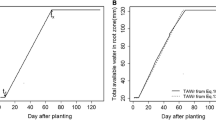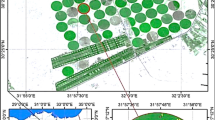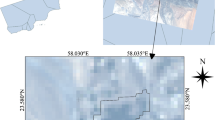Abstract
Determining water stress levels of vegetated surfaces is crucial for irrigation scheduling. This paper aims to evaluate a new method for obtaining crop water stress index (CWSI) based on the estimation of sensible heat flux using an aerodynamic temperature gradient approach. Data were collected on a deficit irrigated maize field at a research farm located in Greeley, Colorado, USA, in 2017 and 2018. The irrigation treatment used subsurface drip. Weather data were measured on-site at 3.3 m above ground level. RED and NIR surface reflectance data were obtained on-site through multispectral radiometer measurements. Nadir surface temperature data were measured using infra-red thermometers at 1 m above canopy. CWSI estimated values were used to assess daily soil water stress index (SWSI), calculated from measurements of volumetric soil water content (VWC) and management allowed depletion (MAD) of 40%. Results show that SWSI is best represented through a non-linear rational CWSI function. Modeled CWSI estimates were compared to measured surface heat fluxes, resulting in a mean bias error of − 0.02 and a root mean square error of 0.09, while errors were 0.02 and 0.06 when compared with observed CWSI based on canopy transpiration measured with plant sap flow devices. Results seem to validate the proposed sensible heat flux-based CWSI model. The CWSI approach presented could be used to manage irrigation and conserve water resources for maize in semi-arid regions.






Similar content being viewed by others
References
Allen RG, Pereira LS, Raes D, Smith M (1998) Crop evapotranspiration—guidelines for computing crop water requirements. FAO Irrigation and drainage paper 56. Food and Agriculture Organization, Rome
ASCE-EWRI (2005) The ASCE Standardized Reference Evapotranspiration Equation. Report 0-7844-0805-X, ASCE Task Committee on Standardization of Reference Evapotranspiration. Reston, Va., American Soc. Civil Engineers
Bastiaanssen WGM, Menenti M, Feddes RA, Holtslag AAM (1998) A remote sensing surface energy balance algorithm for land (SEBAL): 1. Formulation. J Hydrol 212–213:198–212
Ben-Gal A, Agam N, Alchanatis V, Cohen Y, Yermiyahu U, Zipori I, Presnov E, Sprintsin M, Dag A (2009) Evaluating water stress in irrigated olives: correlation of soil water status, tree water status, and thermal imagery. Irrig Sci 27:367–376
Bowen IS (1926) The ratio of heat losses by conduction and by evaporation from any water surface. Phys Rev 27:779–787
Brunsell NA, Gillies R (2002) Incorporating surface emissivity into a thermal atmospheric correction. Photogramm Eng Remote Sens J 68:1263–1269
Brutsaert W (1975) On a derivable formula for long-wave radiation from clear skies. Water Resour Res 11(5):742–744. https://doi.org/10.1029/WR011i005p00742
Brutsaert W (1982) Evaporation into the atmosphere. D. Reidel Publication
Chávez JL (2015) Using canopy temperature as an indicator of plant stress. In: Proceedings of the 27th Annual Central Plains Irrigation Conference (CPIC), Colby, KS, February 17–18, 2015, CPIA, 760 N. Thompson, Colby, Kansas, February 17–18
Chávez JL, Howell TA, Gowda PH, Copeland KS, Prueger JH (2010) Surface aerodynamic temperature modeling over rainfed cotton. Trans ASABE 53(3):759–767
Choudhury BJ, Monteith JL (1988) A four-layer model for the heat budget of homogeneous land surfaces. Q J R Meteorol Soc 114(480):373–398
Chung U, Gbegbelegbe S, Shiferaw B, Robertson R, Yun JI, Tesfaye K, Hoogenboom G, Sonder K (2014) Modeling the effect of a heat wave on maize production in the USA and its implications on food security in the developing world. Weather Clim Extremes J 5–6:67–77
Comas LH, van Bavel MG, Young JS, Chesus KA (2018) Improved installation and validation of sap flow sensors on maize plants. Acta Hort 1222:167–172
Costa-Filho E (2019) Modeling sensible heat flux for vegetated surfaces through an optimized surface aerodynamic temperature approach. M.Sc. Thesis. Colorado State University, Fort Collins, CO, USA, 156 pp
Crawford TM, Duchon CE (1999) An improved parameterization for estimating effective atmospheric emissivity for use in calculating daytime downwelling longwave radiation. J Appl Meteor 38:474–480
Dynamax (2016) Installation of sap flow sensor on maize plants. http://www.dynamax.com/images/uploads/papers/Corn-Installation-SGEX.pdf. Accessed 12 September 2019
Ehrler WL, Idso SB, Jackson RD, Reginato RJ (1978) Diurnal changes in plant water potential and canopy temperature of wheat as affected by drought. Agron J 70:999–1004
Evans JD (1996) Straightforward statistics for the behavioral sciences. Brooks/Cole Publishing, Pacific Grove
Garcia LA, Elhaddad A, Altenhofen J, Hattendorf M (2013) Developing corn regional crop coefficients using a satellite-based energy balance model (ReSET-RASTER) in the south platte river basin of Colorado. J Irrig Drain Eng 139:821–832
Gardner RW, Ehlig CF (1963) The influence of soil water on transpiration by plants. J Geophys Res 68:5719–5724
Han M, Zhang H, DeJonge KC, Comas LH, Gleason S (2018) Comparison of three crop water stress index models with sap flow measurements in maize. Agric Water Manag 203:366–375
Idso SB, Jackson RD, Reginato RJ (1977) Remote sensing of crop yields. Science 196:19–25
Idso SB, Jackson RD, Pinter PJ, Reginato RJ, Hatfield JL (1981) Normalizing the stress–degree–day parameter for environmental variability. Agric Meteorol J 24:45–55
Jackson RD, Idso SB, Reginato RJE, Pinter PJ (1981) Canopy temperature as a crop water stress indicator. Water Resour Res 17:1133–1138
Jackson RD, Kustas WP, Choudhury BJ (1988) A reexamination of the crop water stress index. Irrig Sci 9:309–317. https://doi.org/10.1007/BF00296705
Jackson RB, Sperry JS, Dawson TE (2000) Root water uptake and transport: using physiological processes in global predictions. Trends Plant Sci 5(11):482–488
Jiang Y, Jiang X, Tang R, Li ZL, Zhang Y, Huang C, Ru C (2018) Estimation of daily evapotranspiration using instantaneous decoupling coefficient from the MODIS and field data. IEEE J Selected Topics Appl Earth Observ Remote Sens 11(6):1832–1838
Johnson LF, Trout TJ (2012) Satellite NDVI assisted monitoring of vegetable crop evapotranspiration in California’s San Joaquin valley. Remote Sens 4(2):439–455
Jones HG (1999) Use of infrared thermometry for estimation of stomatal conductance as a possible aid to irrigation scheduling. Agric For Meteorol 95(3):139–149
Monin AS, Obukhov AM (1954) Basic laws of turbulent mixing in the atmosphere near the ground. Trudy Geofiz Inst AN SSSR 24(151):163–187
Ochsner TE, Sauer TJ, Horton B (2006) Field tests of the soil heat flux plate method and some alternatives. Agron J 98:1005–1014
O’Shaughnessy SA, Evett SR, Colaizzi PD, Howell TA (2011) Using radiation thermography and thermometry to evaluate crop water stress in soybean and cotton. Agric Water Manag 98:1523–1535
Osroosh Y, Peters RT, Campbell CS, Zhang Q (2015) Automatic irrigation scheduling of apple trees using theoretical crop water stress index with an innovative dynamic threshold. Comput Electron Agric 118:193–203
Ott RL, Longnecker M (2001) An introduction to statistical methods and data analysis. Cengage Learn, Boston
Panda RK, Behera SK, Kashyap PS (2004) Effective management of irrigation water for maize under stressed conditions. Agric Water Manag 66(3):181–203
Perez PJ, Castellvi F, Ibanez M, Rosell JI (1999) Assessment of reliability of Bowen ratio method for partitioning fluxes. Agric For Meteorol 97(3):141–150
Ramos-Ruiz G, Fernández-Bandera C (2017) Validation of calibrated energy models: common errors. Energies 10:1587. https://doi.org/10.3390/en10101587
Rondeaux G, Steven M, Baret F (1996) Optimization of soil-adjusted vegetation indices. Remote Sens Environ 55:95–107
Sagayo S, Ovando G, Bocco M (2017) Landsat images and crop model for evaluating water stress of rainfed soybean. Remote Sens Environ 198:30–39
Sakuratani T (1981) A heat balance method for measuring water flux in the stem of intact plants. J Agric Meteorol 31:9–17
Saxton KE, Rawls WJ (2006) Soil water characteristic estimates by texture and organic matter for hydrologic solutions. Soil Sci Soc Am J 70:1569–1578
Saxton KE, Rawls WJ, Romberger JS, Papendick RI (1986) Estimating generalized soil–water characteristics from texture. Soil Sci Soc Am J 50(4):1031–1036
Taiz L, Zeiger E, Moller IM, Murphy A (2015) Plant physiology and development. Sinauer Associates Inc, Sunderland
Taylor SA, Ashcroft GL (1972) Physical edaphology. W. H. Freeman and Co, San Francisco
Tubiello FN, Rosenzweig C, Goldberg RA, Jagtap S, Jones JW (2002) Effects of climate change on US crop production: simulation results using two different GCM scenarios. Part I: wheat, potato, maize, and citrus. Clim Res 20:259–270
USDA, NASS (2017) Corn and soybeans production up in 2016, USDA reports. http://nass.usda.gov/Newsroom/printable/2017/01_12_17.pdf. Accessed 10 Dec 2019
Wang R, Bowling LC, Cherkauer KA (2015) Estimation of the effects of climate variability on crop yield in the Midwest USA. Agric For Meteorol 216:141–156
Wang R, Cherkauer K, Bowling L (2016) Corn response to climate stress detected with satellite-based NDVI time series. Remote Sens 8(4):269
Willmott CJ, Robeson SM, Matsuura K (2012) A refined index of model performance. Int J Climatol 32:2088–2094
Yasuda N (1988) Turbulent diffusivity and diurnal variations in the atmospheric boundary layer. Bound-Layer Meteorol 43:209–221
Zarco-Tejada PJ, Gonzalez-Lugo V, Williams LE, Suarez L, Berni JAJ, Goldhamer D, Fereres E (2013) A PRI-based water stress index combining structural and chlorophyll effects: assessment using diurnal narrow-band airborne imagery and the CWSI thermal index. Remote Sens Environ 138:38–50
Acknowledgements
This study was possible thanks to funding received from the U.S. Department of Agriculture (USDA) National Institute of Food and Agriculture (NIFA) under award number 2016-68007-25066, “Sustaining agriculture through adaptive management to preserve the Ogallala aquifer under a changing climate,” and USDA NIFA hatch project number COL00688 through Colorado Agricultural Experiment Station (CAES). The authors also would like to acknowledge Ross Steward, Garrett Banks, and Jon Altenhofen for managing farm activities; Dr. Allan Andales for providing students to help with field work; Katie Ascough, Maria Cristina Capurro, Joshua Wenz, Daniel Raetzman, Garvey Smith, Ashish Masih, Joe Miller, and Brianna Trotter for the collaboration with data collection campaign in 2017 and 2018.
Author information
Authors and Affiliations
Corresponding author
Ethics declarations
Conflict of interest
The authors declare that they have no conflict of interest.
Additional information
Communicated by José L. Chávez.
Publisher's Note
Springer Nature remains neutral with regard to jurisdictional claims in published maps and institutional affiliations.
Rights and permissions
About this article
Cite this article
Costa-Filho, E., Chávez, J.L. & Comas, L. Determining maize water stress through a remote sensing-based surface energy balance approach. Irrig Sci 38, 501–518 (2020). https://doi.org/10.1007/s00271-020-00668-1
Received:
Accepted:
Published:
Issue Date:
DOI: https://doi.org/10.1007/s00271-020-00668-1




